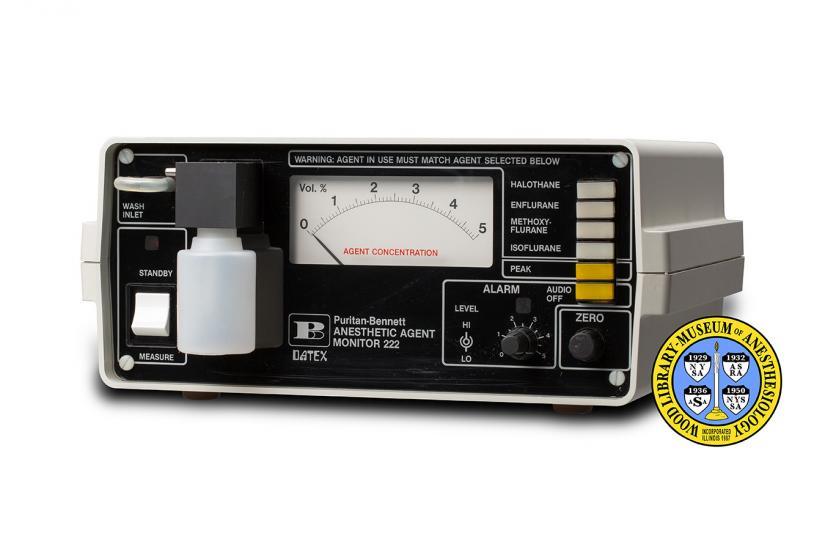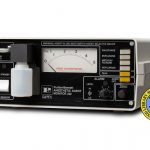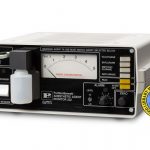Puritan-Bennett 222
Anesthetics can affect the patient’s breathing, heart rate and blood pressure. The Puritan Bennett anesthetic agent monitor, the AAM222, was introduced around 1984. This apparatus measured the concentration of anesthetic gases in the air being administered to the patient. It was calibrated to measure any of four inhalation anesthetics: halothane, enflurane, methoxyflurane or isoflurane. A sample of the air in the breathing circuit was collected, water vapor was extracted from the sample, and the remainder was analyzed using infrared light. The percentage of anesthetic gas was displayed on the needle gauge. The sample could then either be returned to the breathing circuit, or routed to a gas scavenging system. Sampling and measurement were done continuously, keeping the anesthesiologist apprised of the patient’s condition real time. Unlike some later monitors, the AAM222 could not identify individual gases. The buttons on the right side of the monitor were used to set the calibration of the sampling chamber for the correct anesthetic.
Catalog Record: Puritan-Bennett 222
Access Key: alby
Accession No.: 2008-05-14-3 A
Title: Anesthetic agent monitor 222 / Puritan-Bennett ; Datex.
Corporate Author: Puritan-Bennett Corporation.
Corporate Author: Datex Instrumentarium Corporation.
Title variation: Alt Title
Title: Puritan-Bennett Anesthetic agent monitor 222 / Manufactured for
Puritan-Bennett Corporation by Datex Instrumentarium Corp.
Title variation: Alt Title
Title: Puritan-Bennett anesthetic agent monitor 222.
Publisher: Helsinki, Finland : Datex Instrumentarium Corp. ; Wilmington, Massachusetts :
Puritan-Bennett Corporation, [between 1984 and 1986?].
Physical Descript: 1 monitoring device : plastics, metals ; 13.5 x 31 x 32 cm.
Subject: Anesthetics – analysis.
Subject: Monitoring – instrumentation.
Subject: Halothane.
Subject: Enflurane.
Subject: Methoxyflurane.
Subject: Isoflurane.
Note Type: Citation
Notes: The early year in the date range for the possible year of manufacture is
based on the date printed in the “AAM222 Operator’s Manual” and the date
reported in the article, “Anesthesia Gas Monitoring”. The end-date is based
on the infroduction of
Note Type: Citation
Notes: Anesthesia Gas Monitoring: Evolution of a de facto Standard of Care. New
Jersey: ProMed Strategies, LLC; 2009:1-3. https://www.masimo.
com/pdf/phasein/anesthesia-gas-monitoring-evolution-of-a-de-facto-standard-of
care.pdf. Accessed Janaary 20, 2015.
Note Type: Citation
Notes: AAM222 operator’s manual. Massachusetts: Puritan Bennett; 1984.
Note Type: Citation
Notes: Luff NP, White DC. Evaluation of the Datex ‘Normac’ anaesthetic agent monitor
Anaesthesia. 1985;40(6):555-559.
Note Type: Citation
Notes: Westhorpe RN, Ball C. Anaesthetic agent monitoring. Anaesth Intensive Care.
2010;38(6):979.
Note Type: Physical Description
Notes: [1] One anesthetic agent monitor, rectangular in shape; The side, top and
bottom are a light grey plastic; The operational controls are located in the
front of the device, which is black with mostly white lettering; On the left
side of the front a clear plastic tube protrudes in a horseshoe shape; In the
left lower corner is a white switch labeled “STANDBY” above and “MEASURE”
below; To the right of the switch and wash inlet a cube like water trap
extends from the front; A small sample-in port is located on the left side of
the water trap, and a plastic bottle hangs below the trap; To the right of
the water trap is a rectangular display for the concentration of the
anesthetic agent; “Vol. %” is marked in the upper left corner of the
concentration display; A curved scale with increments of .1 % is numbered at
whole increments from 0 to 5; Below the concentration display is a log of
Puritan-Bennett and the following text, “Puritan-Bennett [new line]
ANESTHETIC AGENT [new line] MONITOR 222 [new line] DATEX; To the right of the
concentration display are four white push buttons labeled, “HALOTHANE”,
“ENFLURANE”, “METHOXYFLURANE”, “ISOFLURANE”; Below these is a yellow push
button labeled, “PEAK”; Below these buttons is an area with controls for the
alarm; In the lower right corner is a black dial marked, “ZERO”; Instructions
for use and testing are printed on the top of the device; The back of the
device is black with mostly white print; The back includes a port labeled
“CAL.”, an “OUTPUT” inlet, power cord, and “SAMPLE OUT” port; Markings on the
back include, “MANUFACTURED FOR: [new line] Puritan=Bennett Corporation [new
line] Boston Division [new line] 265 Ballardvale Street [new line} …
{continued at 2].
Note Type: Physical Description
Notes: [2, continued from 1] … Wilmington, Massachusetts 01887 [new line] BY: [new
line] DATEX [new line] Instrumentarium Corp [new line] Finland”; Also marked
on the back is, “Datex Instrumentarium Corp. [new line] Helsinki, Finland
[new line] TYPE AA-102-27-01 [new line] V – 110 SER. 45777 [new line] W 50 Hz
60”; The cord is wound and secured with a plastic strap.
Note Type: Reproduction
Notes: Photographed by Mr. Steve Donisch, in January or February of 2014.
Note Type: Historical
Notes: The most basic function of an anesthesia agent analyzer or monitor is to
measure the concentration of inhalation anesthetics, such as isoflurane, in
the mixture of gases being administered to a patient. This helps the
anesthesiologist know that she is giving the patient the desired dose of
anesthetic.
While the medical device industry worked out the best means of analyzing
anesthetic gases in real time, a number of technologies were tested,
including mass spectrometry and Raman light-scattering. The“Anesthetic Agent
Monitor 222,” introduced by Puritan-Bennett and Datex around 1984, was one of
the early commercial anesthetic gas analyzers to use infrared absorption
spectrophotometry. This involves passing infrared light through a chamber
containing a fresh sample of anesthetic gas. Each anesthetic gas absorbs
infrared light in a unique way, and the differences in absorption patterns
are used to measure the anesthetic gas in the sample.
In addition to measuring concentration, newer anesthetic agent monitors can
detect the presence of anesthetic gases and identify them. This adds an
additional check in preventing the administration of the wrong gas.
The Puritan-Bennet/Datex 222 described here could measure halothane,
enflurane, methoxyflurane, and isoflurane. It was not in production for long
as its successor, the“Datex Normac,” was being evaluated by 1985.
Note Type: Publication
Notes: Meriläinen PT. History of anaesthesia: Datex. A Finnish success story in
anaesthesia monitoring. Eur J Anaesthesiol. 2014;31(7):351-354.
Note Type: Exhibition
Notes: Displayed in the WLM gallery from 2008 to October, 2010; Displayed in the WLM
building Safety Exhibit from February 2010 to March 2014; Selected for the
WLM website.



